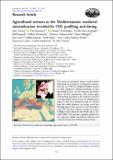Files in this item
Agricultural terraces in the Mediterranean : medieval intensification revealed by OSL profiling and dating
Item metadata
| dc.contributor.author | Turner, Sam | |
| dc.contributor.author | Kinnaird, Tim | |
| dc.contributor.author | Varinlioğlu, Günder | |
| dc.contributor.author | Şerifoğlu, Tevfik Emre | |
| dc.contributor.author | Koparal, Elif | |
| dc.contributor.author | Demirciler, Volkan | |
| dc.contributor.author | Athanasoulis, Dimitris | |
| dc.contributor.author | Ødegård, Knut | |
| dc.contributor.author | Crow, Jim | |
| dc.contributor.author | Jackson, Mark | |
| dc.contributor.author | Bolòs, Jordi | |
| dc.contributor.author | Sánchez-Pardo, José Carlos | |
| dc.contributor.author | Carrer, Francesco | |
| dc.contributor.author | Sanderson, David | |
| dc.contributor.author | Turner, Alex | |
| dc.date.accessioned | 2021-06-01T11:30:19Z | |
| dc.date.available | 2021-06-01T11:30:19Z | |
| dc.date.issued | 2021-06-01 | |
| dc.identifier | 274449403 | |
| dc.identifier | d2aa28e7-c062-47a8-b1d6-7d2bb1bd64c4 | |
| dc.identifier | 000656576800017 | |
| dc.identifier | 85107408323 | |
| dc.identifier.citation | Turner , S , Kinnaird , T , Varinlioğlu , G , Şerifoğlu , T E , Koparal , E , Demirciler , V , Athanasoulis , D , Ødegård , K , Crow , J , Jackson , M , Bolòs , J , Sánchez-Pardo , J C , Carrer , F , Sanderson , D & Turner , A 2021 , ' Agricultural terraces in the Mediterranean : medieval intensification revealed by OSL profiling and dating ' , Antiquity , vol. 95 , no. 381 , pp. 773-790 . https://doi.org/10.15184/aqy.2020.187 | en |
| dc.identifier.issn | 0003-598X | |
| dc.identifier.other | RIS: urn:BD1D247470A839BE801E992865C635A2 | |
| dc.identifier.uri | https://hdl.handle.net/10023/23294 | |
| dc.description | Funding for fieldwork and analysis has been provided by grants from the Newton Fund administered by the British Academy (AF140007 & AF160103), UK Research and Innovation (AH/P005829/1 & AH/P014453/1), the Scientific and Technological Research Council of Turkey (116K829), the European Commission (H2020 657050), Dumbarton Oaks (Washington, D.C.), Seven Pillars of Wisdom Trust (UK), Ministry of Economy and Competitiveness (HAR2012-35022) (Spain), Xunta de Galicia (2016 PG-065) (Spain). | en |
| dc.description.abstract | The history of agricultural terraces remains poorly understood due to problems in dating their construction and use. This has hampered broader research on their significance, limiting knowledge of past agricultural practices and the long-term investment choices of rural communities. The authors apply OSL profiling and dating to the sediments associated with agricultural terraces across the Mediterranean region to date their construction and use. Results from five widely dispersed case studies reveal that although many terraces were used in the first millennium AD, the most intensive episodes of terrace-building occurred during the later Middle Ages (c. AD 1100–1600). This innovative approach provides the first large-scale evidence for both the longevity and medieval intensification of Mediterranean terraces. | |
| dc.format.extent | 18 | |
| dc.format.extent | 7422072 | |
| dc.language.iso | eng | |
| dc.relation.ispartof | Antiquity | en |
| dc.subject | Mediterranean | en |
| dc.subject | Landscape archaeology | en |
| dc.subject | Agricultural terraces | en |
| dc.subject | OSL-PD | en |
| dc.subject | CC Archaeology | en |
| dc.subject | DAS | en |
| dc.subject | SDG 2 - Zero Hunger | en |
| dc.subject.lcc | CC | en |
| dc.title | Agricultural terraces in the Mediterranean : medieval intensification revealed by OSL profiling and dating | en |
| dc.type | Journal article | en |
| dc.contributor.institution | University of St Andrews. School of Earth & Environmental Sciences | en |
| dc.identifier.doi | https://doi.org/10.15184/aqy.2020.187 | |
| dc.description.status | Peer reviewed | en |
This item appears in the following Collection(s)
Items in the St Andrews Research Repository are protected by copyright, with all rights reserved, unless otherwise indicated.

